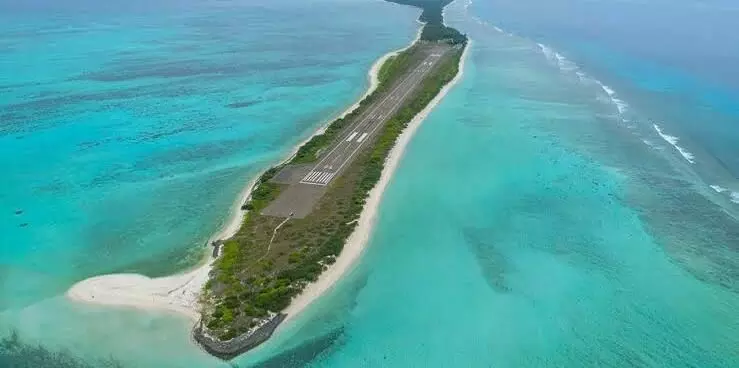
Many of Lakshadweep islands may vanish by 2035: Study
text_fieldsA study conducted by IIT Kharagpur has found, that many islands of the Lakshadweep archipelago may disappear by 2035, as per a report by the Mongabay. The study report published in the international magazine Elsevier indicates sea-level rise as the cause of the disappearance and highlights the importance of moving the islanders to safer islands.
What's 'on shore' for the islands?
The Lakshadweep is an archipelago of 36 islands of 32 sq km. It comprises twelve atolls, three reefs, five submerged banks and ten inhabited islands, populated with 64,000 people with a population density of 2000/sq km. The union territory is one of the most densely populated in rural India.
Prasad K Bhaskaran, an expert on wave ocean dynamics, says that even if the greenhouse gas concentration is low, sea levels are expected to rise to dangerous levels towards the end of this century. The greenhouse gases increase global warming, which melts polar icecaps and ultimately results in rising sea levels. This expected rise could be 0.78metres, which could happen roughly in two generations, Bhaskaran said, quoting the study he co-authored.
The projected land loss could do considerable damage to livelihood as the islanders' residential area is too close to the present coastline. Islands such as Chetlat, Amini, Kavaratti, Minicoy and many showed larger odds of land loss, which could be nearly 60 per cent shoreline loss due to rise in sea level. But Androth Island showed the least rate of inundation under all kind of climatic change. In addition, the only airport in the UT, located at Agatti Island, is prone to inundation and is likely to suffer severe damages. According to Aysha Jennath, co-author, the base map for their study was of the year 2000, and the predicted damages must have started already.
Sea level rise will boost the coastal erosion process and push the shorelines further into the islands or inundate the islands to extinction. It may also expose areas that were under protection before. The Lakshadweep islands are particularly low concerning the sea levels, and coastal slopes are gentle, resulting in the considerable invasion of the sea into the island.
Researchers opined that the Arabian Sea, which used to be calmer than the Bay of Bengal, is getting more active with cyclones due to climate change. They say that high energy waves that smash the shores are now destabilising the natural cycle of shore erosion and shore accumulation. Human actions have influenced it both directly and indirectly.
Depleting coral reefs
The Lakshadweep coral barriers that protected its shoreline against waves and storms are now under demanding pressure to keep up with the sudden changes it was made to go through like other coral reefs worldwide.
Bleaching event of corals, which happens when seawater temperature increases, could cause depletion of coral reefs. As the temperature increases, the reefs will be under stress and subject to mortality. Lakshadweep faced three major bleaching events during 1998, 2010 and 2016, which was kicked into motion by the El Nino events of the respective years. Though the reefs recovered from 1998's, the 2010s recovery was slower, and the interval was narrow since another event happened during 2016. The Ockhi's hit in 2018 ended in a coral collapse in the islands. The narrowing intervals between bleaching coupled with commercial fishing among reefs in recent years undermined the resilience of these ecosystems.
The bleaching events are expected to happen more in the next few decades, which will be more severe if no action is taken regarding greenhouse gas emissions. This will ultimately reduce the reef's capacity to stand against sea waves and sea-level rise.
According to the Intergovernmental Panel on Climate Change (IPCC), coral reefs would slump up to 70 to 90 per cent with global warming of 1.5 degree Celsius. It will reach more than 99 per cent when warming comes to 2 degree Celsius. The Indian Ocean, which includes the Bay of Bengal and the Arabian sea, is the fastest-warming tropical ocean in the entire world.
The need of the hour
Regulation is needed for the islands for tourism and industries as its ecosystem is considerably weak. Climate change has an impact on the island's fragile ecosystem, and it was acknowledged in a paper published in 2012 by the Lakshadweep administration. The paper emphasised that while erosion occurs due to storms, wave attacks, and the destruction of coral reefs, the projected sea-level rise will worsen.
Restoring coral reefs by coral farming with heat resistant varieties is what Aysha Jennath suggests. She also says that instead of rugged armouring solutions like sea walls or tetrapods, soft engineering options like geotubes or geo bags and reef balls should be introduced against shore erosion and regain lost shores. R.M. Hidayathulla, a researcher and native of Lakshadweep who reported the disappearance of a small atoll within the archipelago in 2017, agrees to natural means to protect islands by suggesting mangroves.























